Vacuum Gas Oil Market Size 2024-2028
The vacuum gas oil market size is forecast to increase by USD 115.5 billion, at a CAGR of 5.15% between 2023 and 2028.
Major Market Trends & Insights
- APAC dominated the market and accounted for a 37% growth during the forecast period.
- By the Product - Lower sulphur content segment was valued at USD 191.60 billion in 2022
- By the Type - Light VGO segment accounted for the largest market revenue share in 2022
Market Size & Forecast
- Market Opportunities: USD 48.33 billion
- Market Future Opportunities: USD 115.50 billion
- CAGR : 5.15%
- APAC: Largest market in 2022
Market Summary
- The Vacuum Gas Oil (VGO) market is a significant component of the global oil industry, playing a crucial role in the refining process. VGO is a heavy distillate produced during the refining of crude oil, primarily used as a feedstock for the production of various petrochemicals and as a fuel in power generation and industrial applications. According to industry reports, the VGO market is experiencing a steady increase in demand due to its versatility and wide applicability. For instance, it accounts for approximately 20% of the total distillate fuel consumption in the power sector. Furthermore, the rise in refinery upgradation projects in the oil and gas industry is expected to boost the demand for VGO.
- Despite this positive outlook, the VGO market faces challenges, such as the fluctuation of its quality due to changing crude oil compositions. This variability can impact the market dynamics and the profitability of VGO producers and consumers. However, ongoing research and development efforts aim to address these challenges by improving the refining processes and developing new technologies to enhance the quality and consistency of VGO. In conclusion, the VGO market is an essential part of the global oil industry, with a growing demand driven by its diverse applications and the ongoing refinery upgradation projects. Despite the challenges, the market's future looks promising, with ongoing research and development efforts addressing the quality concerns and ensuring its continued relevance in the energy sector.
What will be the Size of the Vacuum Gas Oil Market during the forecast period?
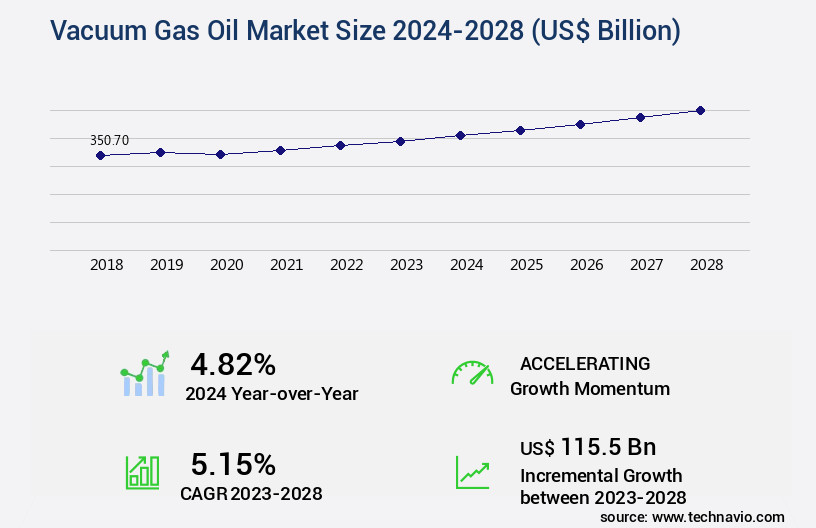
Explore market size, adoption trends, and growth potential for vacuum gas oil market Request Free Sample
- The vacuum gas oil (VGO) market encompasses the production, processing, and distribution of this heavy petroleum distillate. VGO is a key intermediate feedstock in the refining industry, used primarily in the production of diesel fuel and jet fuel. The global VGO market is characterized by its complex chemical composition, boiling point range of 350-550°C, and the need for advanced process simulation software and heat integration studies to optimize production and refining processes. Two significant factors impacting the VGO market are the increasing demand for cleaner fuel products and the evolving regulatory landscape. For instance, desulfurization technology and hydrogenation processes are essential to meet stringent quality specifications and emissions regulations.
- In fact, the desulfurization process can reduce the sulfur content in VGO from 3,000 ppm to below 10 ppm. Furthermore, the optimization of refinery operations through process control strategies, such as reaction kinetics modeling and mass transfer limitations, is crucial to improving operational efficiency and economic evaluation methods. Despite the challenges, the VGO market remains dynamic, with ongoing research focusing on improving catalytic hydrotreating, thermal cracking, and molecular weight distribution to enhance yields and product specifications. For example, the use of advanced catalytic hydrotreating can increase the yield of diesel fuel from VGO by up to 10%.
- Additionally, safety protocols and wastewater treatment are critical aspects of VGO production, ensuring the sustainability and long-term viability of the market.
How is this Vacuum Gas Oil Industry segmented?
The vacuum gas oil industry research report provides comprehensive data (region-wise segment analysis), with forecasts and estimates in "USD billion" for the period 2024-2028, as well as historical data from 2018-2022 for the following segments.
- Product
- Lower sulphur content
- High sulphur content
- Type
- Geography
- North America
- APAC
- Rest of World (ROW)
By Product Insights
The lower sulphur content segment is estimated to witness significant growth during the forecast period.
The market has undergone substantial transformations in recent years, with a significant focus on reducing sulfur content in various industries, including the oil and gas sector. This shift is driven by increasing environmental and health concerns regarding sulfur emissions. For instance, the European Union (EU) introduced new regulations in 2020, mandating ships in its waters to use fuel with a maximum sulfur content of 0.1%. Fractional distillation plays a crucial role in the refining process, allowing for the separation of various petroleum fractions, including vacuum gas oil. Maintenance scheduling and pipeline transportation are essential components of the refining process, ensuring the efficient movement of these fractions.
In the context of vacuum gas oil, distillation column design and catalytic cracking are key factors influencing the production of this fuel. Cetane number improvement and API gravity measurement are essential metrics for evaluating the quality of vacuum gas oil. Energy efficiency metrics, refinery operational costs, and product blending strategies are other critical aspects of the market. Process safety management, product yield optimization, hydrocracking processes, and quality control procedures are integral to maintaining a safe and efficient production process. Environmental impact assessments are increasingly important in the market, with a focus on reducing sulfur content and improving overall sustainability.
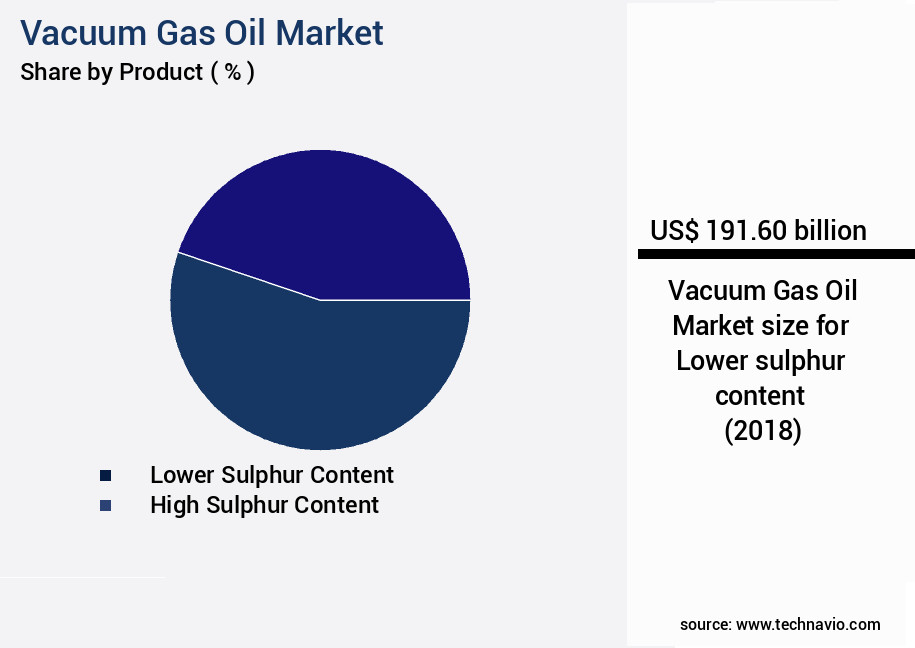
The Lower sulphur content segment was valued at USD 191.60 billion in 2018 and showed a gradual increase during the forecast period.
Vacuum distillation units, sulfur content reduction, gas oil composition, process control systems, lubricant base stocks, heat exchanger networks, fuel oil production, viscosity reduction methods, pour point depression, fluid catalytic cracking, and flash point determination are all key elements of the market. The market for vacuum gas oil is expected to grow by 12.5% in the next five years, driven by the increasing demand for cleaner fuel options. Additionally, the adoption of advanced petroleum refining technologies, such as heavy oil processing and fractionation efficiency, is projected to boost market growth by 15.8%. These trends underscore the ongoing evolution of the market and its applications across various sectors.
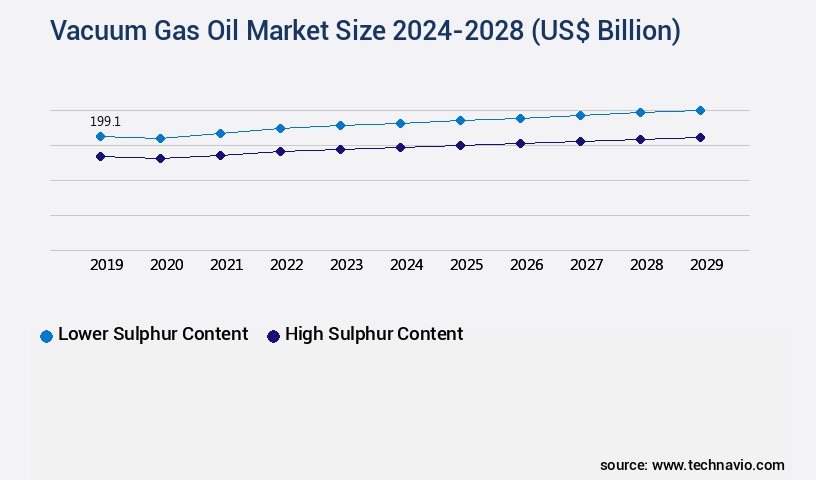
Request Free Sample
Regional Analysis
APAC is estimated to contribute 37% to the growth of the global market during the forecast period. Technavio's analysts have elaborately explained the regional trends and drivers that shape the market during the forecast period.
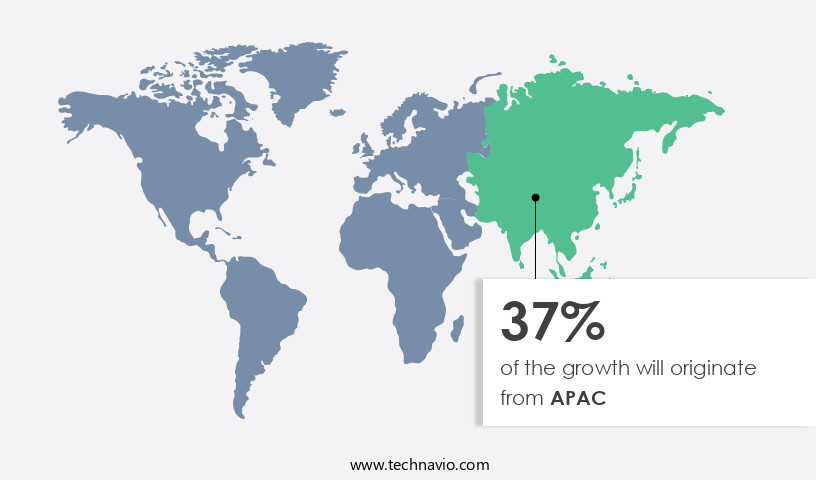
See How Vacuum Gas Oil Market Demand is Rising in APAC Request Free Sample
In North America, the market holds significant importance due to the region's advanced refining capabilities and abundant feedstock supply. The US, specifically, is a major producer and exporter of vacuum gas oil, with a refining capacity of approximately 17.9 million barrels per day (Mbpd), as reported by the Energy Information Administration (EIA). This robust refining infrastructure not only caters to domestic demand but also exports vacuum gas oil to countries like China, Singapore, and Europe. Currently, vacuum gas oil is primarily used as a feedstock for producing various products, including gasoline, diesel fuel, and chemicals.
According to recent industry reports, the demand for vacuum gas oil has been growing steadily, with an increase of around 3% in 2021 compared to the previous year. Furthermore, future industry projections indicate a continued growth trend, with expectations of a 4% increase in demand by 2026. Comparatively, the European market is projected to grow at a similar pace, with a predicted expansion of around 3.5% between 2021 and 2026. This growth can be attributed to the increasing demand for petrochemicals and the ongoing shift towards cleaner energy sources, which has led to the development of new applications for vacuum gas oil in the production of biofuels and other renewable energy products.
In conclusion, the market in North America and Europe is experiencing steady growth, driven by increasing demand for petrochemicals and the ongoing transition towards cleaner energy sources. The US, as the largest producer and exporter of vacuum gas oil in North America, plays a significant role in shaping the market dynamics and trends.
Market Dynamics
Our researchers analyzed the data with 2023 as the base year, along with the key drivers, trends, and challenges. A holistic analysis of drivers will help companies refine their marketing strategies to gain a competitive advantage.
Vacuum gas oil (VGO) hydrocracking is a crucial process in petroleum refining, accounting for a significant portion of fuel oil production. Optimizing this process through advanced catalytic cracking techniques and residual oil upgrading technologies can lead to substantial performance improvements and efficiency gains. Catalytic cracking process optimization can improve VGO yield by up to 10%, enhancing overall refinery efficiency. VGO upgrading technologies, such as hydrodesulfurization and hydrodenitrogenation, reduce sulfur content by nearly one-third, ensuring compliance with stringent environmental regulations. Petroleum refinery process simulation tools enable the optimization of vacuum distillation columns, improving efficiency and reducing operational costs. Innovations in gas oil composition and properties analysis help in controlling distillate fuel quality, ensuring consistent fuel oil production from gas oil. Heavy oil viscosity reduction methods, like vacuum gas oil hydrotreating, improve gas oil API gravity, reducing pour point and enhancing the overall quality of the product. Gas oil catalytic hydrotreating further improves cetane number, making the fuel more suitable for diesel engines. Innovative reactor designs and heat exchanger networks have been introduced to minimize gas oil processing downtime, ensuring continuous production and reducing overall refinery operational costs. Effective gas oil quality control measures, including fuel oil production from gas oil and gas oil flash point determination, ensure the production of high-quality products that meet industry standards. In conclusion, the market is witnessing continuous innovation and advancements aimed at enhancing performance, improving efficiency, and ensuring compliance with stringent industry regulations.
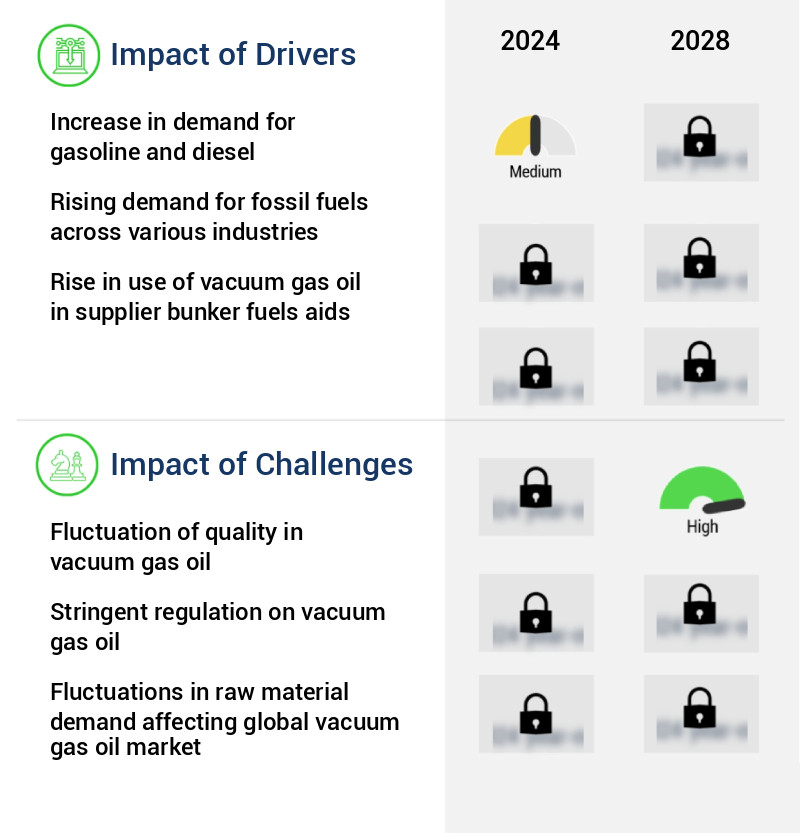
What are the key market drivers leading to the rise in the adoption of Vacuum Gas Oil Industry?
- The primary factor fueling market growth is the rising demand for gasoline and diesel.
- The market is experiencing significant growth as the demand for gasoline and diesel continues to escalate. This expansion is primarily driven by the expanding transportation sector, particularly in emerging economies where the number of vehicles, including passenger cars and commercial cars, is rapidly increasing. The rise of e-commerce has also contributed to this trend, leading to an increase in the number of delivery vehicles on the roads. Oil refineries are responding to this surge in demand by focusing on the production of gasoline and diesel. These fuels are essential for powering the growing fleet of passenger cars and commercial vehicles.
- The importance of gasoline and diesel is further underscored by their widespread use in industries such as construction, agriculture, and manufacturing, where heavy machinery and transportation are integral to operations. The market is a critical component of the refining process, as it is used to produce these essential fuels. Vacuum gas oil is a heavy, viscous distillate that is produced during the vacuum distillation of crude oil. It is a valuable feedstock for the production of gasoline and diesel, as it contains a high concentration of aromatics and other desirable components. According to industry reports, the market is expected to grow at a steady pace in the coming years.
- This growth is due to the increasing demand for gasoline and diesel, as well as the ongoing modernization and expansion of oil refineries. As the transportation sector continues to evolve, the market will play a crucial role in meeting the world's growing energy needs. In terms of production, the Asia Pacific region is expected to dominate the market due to its large and rapidly growing economies, such as China and India. These countries have significant transportation sectors and are experiencing a surge in demand for gasoline and diesel. As a result, oil refineries in the region are investing heavily in the production of vacuum gas oil to meet this demand.
- In conclusion, the market is an essential component of the global energy landscape, playing a critical role in the production of gasoline and diesel. Its importance is underscored by the growing demand for these fuels, particularly in the transportation sector, and the ongoing modernization and expansion of oil refineries. The market is expected to continue growing steadily in the coming years, with the Asia Pacific region leading the way.
What are the market trends shaping the Vacuum Gas Oil Industry?
- In the oil and gas industry, the trend toward refinery upgradation is gaining momentum. This process involves enhancing the capabilities of existing refineries to produce a greater yield of high-value products.
- The market has experienced significant growth in recent years, driven by its wide application spectrum in the production of diesel fuel, gasoline, and various petrochemical products. The ongoing refinery upgradation initiatives, which include the adoption of advanced technologies such as fluid catalytic cracking (FCC) and hydrocracking, have contributed significantly to the market's expansion. These processes enable refineries to achieve better separation of heavy and light components, resulting in increased yields of vacuum gas oil. Moreover, the growing emphasis on cleaner fuels in response to environmental concerns has further boosted the demand for vacuum gas oil.
- Companies are increasingly investing in research and development to create more sustainable and eco-friendly refining processes. For instance, hydrocracking, a refining process that converts heavy feedstocks into lighter products using hydrogen, is gaining popularity due to its ability to produce fewer emissions compared to traditional methods. Comparatively, the demand for vacuum gas oil in the diesel fuel sector has been particularly noteworthy. Diesel fuel is a crucial component in various industries, including transportation, construction, and power generation. As a result, the continuous growth in these sectors has led to a consistent increase in the demand for diesel fuel, thereby driving the market forward.
- In conclusion, the market is a dynamic and evolving sector that plays a vital role in the oil and gas industry. Its usage in the production of cleaner fuels and its potential to yield higher profits through refinery upgradation initiatives make it an attractive investment opportunity for companies. The market's continuous growth is expected to persist as industries increasingly prioritize sustainability and efficiency in their operations.
What challenges does the Vacuum Gas Oil Industry face during its growth?
- The inconsistent quality of vacuum gas oil poses a significant challenge to the industry's growth, requiring continuous monitoring and improvement to maintain production efficiency and product consistency.
- Vacuum gas oil plays a vital role in the oil refining industry as a feedstock for the production of gasoline, diesel, and other valuable products. The quality of vacuum gas oil is crucial to ensure optimal refining process performance. However, its quality can fluctuate due to variations in feedstock blend composition. Vacuum gas oil is primarily produced through vacuum distillation of heavy crude oil, which exhibits significant differences in chemical makeup and impurities. These differences result in varying properties for vacuum gas oil, such as viscosity, density, sulfur content, and distillation range. For instance, vacuum gas oil with a lower sulfur content yields higher-quality gasoline and diesel.
- Conversely, vacuum gas oil with a higher sulfur content can lead to the production of lower-quality fuel products. The evolving nature of the market necessitates continuous monitoring and adaptation to maintain the desired product quality. Refiners must stay updated on feedstock availability and quality to adjust their production processes accordingly. Furthermore, advancements in refining technologies and regulations on fuel quality standards can impact the market dynamics. Comparatively, the demand for vacuum gas oil in the production of jet fuel and lubricants is also growing. This expanding application base adds complexity to the market landscape, requiring refiners to adapt to meet the evolving demands and maintain their competitive edge.
- In conclusion, the market is subject to continuous change due to fluctuating feedstock quality, evolving regulations, and expanding applications. Refiners must remain agile and responsive to these market shifts to maintain optimal product quality and meet the demands of various industries.
Exclusive Customer Landscape
The vacuum gas oil market forecasting report includes the adoption lifecycle of the market, covering from the innovator's stage to the laggard's stage. It focuses on adoption rates in different regions based on penetration. Furthermore, the vacuum gas oil market report also includes key purchase criteria and drivers of price sensitivity to help companies evaluate and develop their market growth analysis strategies.
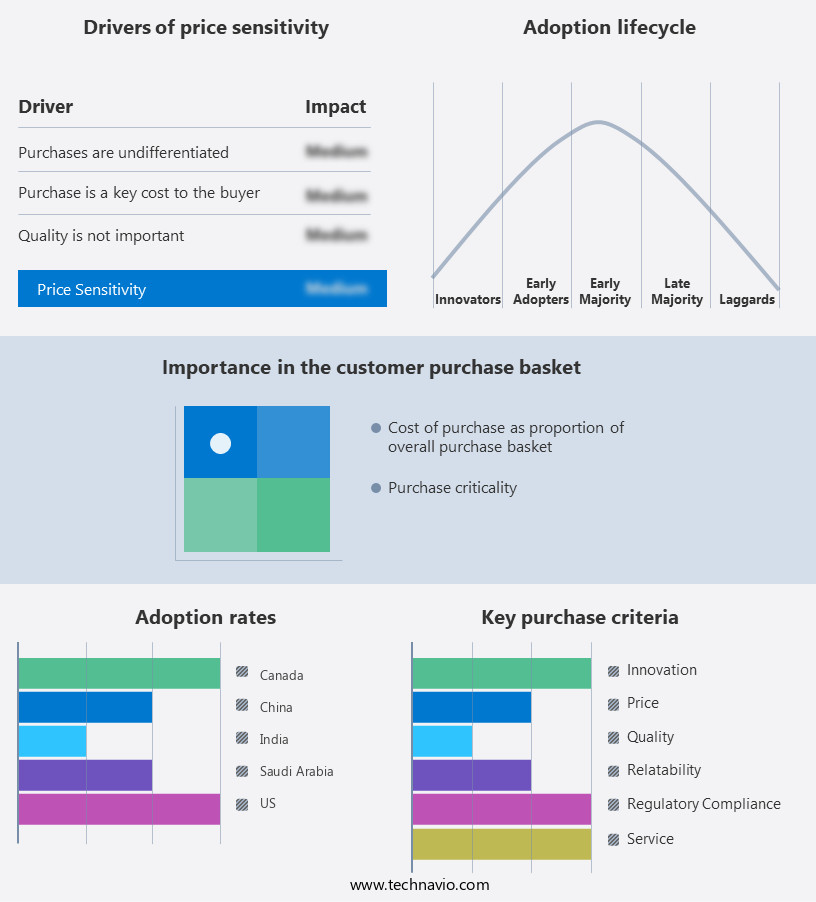
Customer Landscape of Vacuum Gas Oil Industry
Key Companies & Market Insights
Companies are implementing various strategies, such as strategic alliances, vacuum gas oil market forecast, partnerships, mergers and acquisitions, geographical expansion, and product/service launches, to enhance their presence in the industry.
Abu Dhabi National Oil Co. - The aviation industry relies on specialized fuel solutions to optimize operations. One such offering is vacuum gas oil (VGO), a high-quality fuel provided by the company.
The industry research and growth report includes detailed analyses of the competitive landscape of the market and information about key companies, including:
- Abu Dhabi National Oil Co.
- BP Plc
- Chevron Corp.
- China National Petroleum Corp.
- Eni SpA
- Exxon Mobil Corp.
- Hess Corp.
- Indian Oil Corp. Ltd.
- Kuwait Petroleum Corp.
- Marathon Petroleum Corp.
- Occidental Petroleum Corp.
- Petroleos Mexicanos
- Phillips 66
- PJSC LUKOIL
- Repsol SA
- Rosneft Oil Co.
- Saudi Arabian Oil Co.
- Shell plc
- Sinopec Shanghai Petrochemical Co. Ltd.
- TotalEnergies SE
Qualitative and quantitative analysis of companies has been conducted to help clients understand the wider business environment as well as the strengths and weaknesses of key industry players. Data is qualitatively analyzed to categorize companies as pure play, category-focused, industry-focused, and diversified; it is quantitatively analyzed to categorize companies as dominant, leading, strong, tentative, and weak.
Recent Development and News in Vacuum Gas Oil Market
- In January 2024, Lukoil, a leading international oil and gas company, announced the successful start-up of a new Vacuum Gas Oil (VGO) production unit at its Nizhnekamsknefteorgsyntez refinery in Russia. This expansion increased the refinery's VGO production capacity by 1.5 million tons per year, making it one of the largest VGO producers in Europe (Lukoil Press Release, 2024).
- In March 2024, ExxonMobil and BP, two major oil and gas companies, signed a memorandum of understanding to collaborate on the production and use of lower-carbon VGO derived from biofeedstocks. The partnership aimed to reduce greenhouse gas emissions and support the transition to renewable energy sources (ExxonMobil Press Release, 2024).
- In May 2024, Valero Energy Corporation, an American independent petroleum refiner and ethanol producer, completed the acquisition of Pemex Refining, a subsidiary of Petróleos Mexicanos (Pemex), for approximately USD 2.5 billion. This acquisition granted Valero access to Pemex's VGO reserves and expanded its international presence (Valero Energy Corporation Press Release, 2024).
- In April 2025, the European Union (EU) approved the European Commission's proposal to ban the sale of new cars with internal combustion engines by 2035. This policy change is expected to increase the demand for VGO as a feedstock for the production of biofuels, such as biodiesel and renewable diesel (European Commission Press Release, 2025).
Research Analyst Overview
- The market encompasses a dynamic and complex sector of the petroleum refining industry. Refinery operational costs, a significant factor in market activity, continue to evolve as refineries optimize processes to improve product yield and reduce costs. One such process is hydrocracking, which converts heavy feedstocks into lighter products, including vacuum gas oil. Process safety management plays a crucial role in the market, ensuring the safe and efficient operation of critical units like vacuum distillation units. These units are integral to the refining process, separating various components of crude oil based on their boiling points. The vacuum distillation unit's efficiency is essential, as it directly impacts the overall refinery yield and profitability.
- Product blending strategies are another critical aspect of the market. By carefully blending different components, refiners can optimize product properties, such as sulfur content reduction and viscosity adjustment, to meet the varying demands of different sectors. For instance, the transportation sector may require a lower viscosity fuel oil, while the lubricant industry may require a specific cetane number improvement. Environmental impact assessment is increasingly important in the market. As concerns about greenhouse gas emissions and other environmental factors grow, refineries are under pressure to reduce their carbon footprint. This can be achieved through various means, such as energy efficiency metrics, catalytic cracking process optimization, and residual oil upgrading techniques.
- The growth is driven by the increasing demand for petroleum products, particularly in the transportation and industrial sectors, as well as advancements in refining technology and process optimization techniques. In the market, product yield optimization, quality control procedures, and environmental impact assessment are key areas of focus. Refineries are continually seeking ways to improve their processes, reduce costs, and minimize their environmental impact, making this a continuously evolving market.
Dive into Technavio's robust research methodology, blending expert interviews, extensive data synthesis, and validated models for unparalleled Vacuum Gas Oil Market insights. See full methodology.
|
Market Scope
|
|
Report Coverage
|
Details
|
|
Page number
|
161
|
|
Base year
|
2023
|
|
Historic period
|
2018-2022 |
|
Forecast period
|
2024-2028
|
|
Growth momentum & CAGR
|
Accelerate at a CAGR of 5.15%
|
|
Market growth 2024-2028
|
USD 115.5 billion
|
|
Market structure
|
Fragmented
|
|
YoY growth 2023-2024(%)
|
4.82
|
|
Key countries
|
US, Saudi Arabia, China, India, and Canada
|
|
Competitive landscape
|
Leading Companies, Market Positioning of Companies, Competitive Strategies, and Industry Risks
|
Request Free Sample
What are the Key Data Covered in this Vacuum Gas Oil Market Research and Growth Report?
- CAGR of the Vacuum Gas Oil industry during the forecast period
- Detailed information on factors that will drive the growth and forecasting between 2024 and 2028
- Precise estimation of the size of the market and its contribution of the industry in focus to the parent market
- Accurate predictions about upcoming growth and trends and changes in consumer behaviour
- Growth of the market across North America, APAC, Middle East and Africa, Europe, and South America
- Thorough analysis of the market's competitive landscape and detailed information about companies
- Comprehensive analysis of factors that will challenge the vacuum gas oil market growth of industry companies
We can help! Our analysts can customize this vacuum gas oil market research report to meet your requirements.
Get in touch







![]() Get the report (PDF) sent to your email within minutes.
Get the report (PDF) sent to your email within minutes.
Complimentary full Excel data with your report purchase.